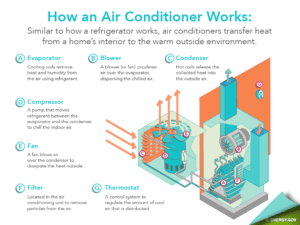
Understanding the Mechanics: How Do Air Conditioning Systems Work?

As the scorching heat of summer approaches, the hum of air conditioning units becomes the soundtrack of relief for many. But have you ever stopped to ponder how these miraculous machines actually work? From chilling out in our homes to keeping our workplaces comfortable, air-conditioning systems play a vital role in our daily lives. Let’s delve into the mechanics behind these cool wonders and unravel the mystery of how air conditioning systems function.
The Basics: Refrigeration Cycle
At the heart of every air conditioning system lies the refrigeration cycle, a marvel of thermodynamics that makes cooling possible. This cycle relies on the principles of evaporation and condensation to transfer heat from one place to another. Here’s a simplified breakdown of the process:
- Evaporation: The cycle begins with a refrigerant, a substance with a low boiling point, flowing into the evaporator coil. As warm air from the room blows over the coil, the refrigerant absorbs heat from the air, causing it to evaporate into a gas.
- Compression: Next, the compressor kicks into action, compressing the gaseous refrigerant and raising its temperature and pressure. This high-pressure gas then moves to the condenser coil.
- Condensation: In the condenser coil, the hot, pressurized gas releases its heat to the surrounding air or to water, depending on the system. As a result, the refrigerant condenses back into a liquid state.
- Expansion Valve: After condensation, the liquid refrigerant passes through an expansion valve, where its pressure drops dramatically. This sudden decrease in pressure causes the refrigerant to evaporate once again, restarting the cycle.
By continuously repeating this cycle, air conditioning systems can effectively remove heat from indoor spaces, keeping them cool and comfortable even in the midst of a sweltering summer day.

Source: U.S. Department of Energy – Energy Saver 101 Infographic
Components of an Air Conditioning System
While the refrigeration cycle forms the backbone of air conditioning technology, several key components work together to make the system function seamlessly. Let’s take a closer look at these components:
- Evaporator Coil: Located indoors, the evaporator coil is where the refrigerant absorbs heat from the indoor air, causing it to cool down.
- Compressor: Often referred to as the heart of the system, the compressor’s role is to pressurize the refrigerant gas, increasing its temperature and facilitating the transfer of heat.
- Condenser Coil: Positioned outdoors, the condenser coil dissipates the heat absorbed from the indoor air into the surrounding environment, allowing the refrigerant to condense back into a liquid.
- Expansion Valve: Serving as a gateway between the high-pressure and low-pressure sides of the system, the expansion valve regulates the flow of refrigerant, ensuring optimal performance.
- Air Handler: The air handler circulates the conditioned air throughout the building, distributing cool air while simultaneously filtering out impurities.
By working in harmony, these components form a cohesive system capable of maintaining comfortable indoor temperatures regardless of the weather conditions outside.
Types of Air Conditioning Systems
Air conditioning systems come in various shapes and sizes, each catering to specific needs and preferences. Some common types include:
- Central Air Conditioning: Ideal for larger homes or buildings, central air conditioning systems use ducts to distribute cool air throughout the entire space.
- Ductless Mini-Split Systems: As the name suggests, these systems don’t require ductwork and are suitable for cooling individual rooms or areas.
- Window Air Conditioners: Popular in apartments or smaller spaces, window air conditioners are self-contained units installed directly into windows.
- Portable Air Conditioners: Offering flexibility and convenience, portable air conditioners can be moved from room to room as needed, providing targeted cooling wherever it’s required.
Air conditioning systems operate on the principles of thermodynamics, utilizing the refrigeration cycle to remove heat from indoor spaces and maintain comfortable temperatures. By understanding the mechanics behind these cooling wonders and the role of key components, we gain a greater appreciation for the technology that keeps us cool and comfortable year-round. Whether it’s a central air system cooling an entire building or a portable unit providing relief in a single room, air conditioning has undoubtedly revolutionized the way we experience hot weather. Regardless of which type of system works for your home or office, knowing how air conditioners work can help you choose the best AC system. And, it will help you to better understand the choices your HVAC contractor is presenting.
Post Categories
Why Choose Us?
- We're strategically located in Pearland, TX
- Expertise to service all of your HVAC equipment
- Our technicians are NATE-certified
- We are an ACCA member company
- BBB accredited south Texas HVAC business
- We stand behind all of our HVAC work
